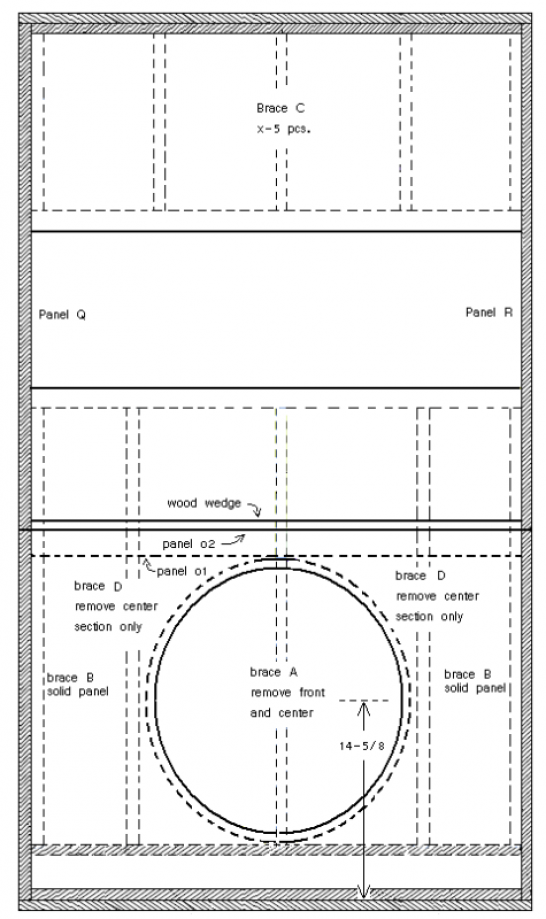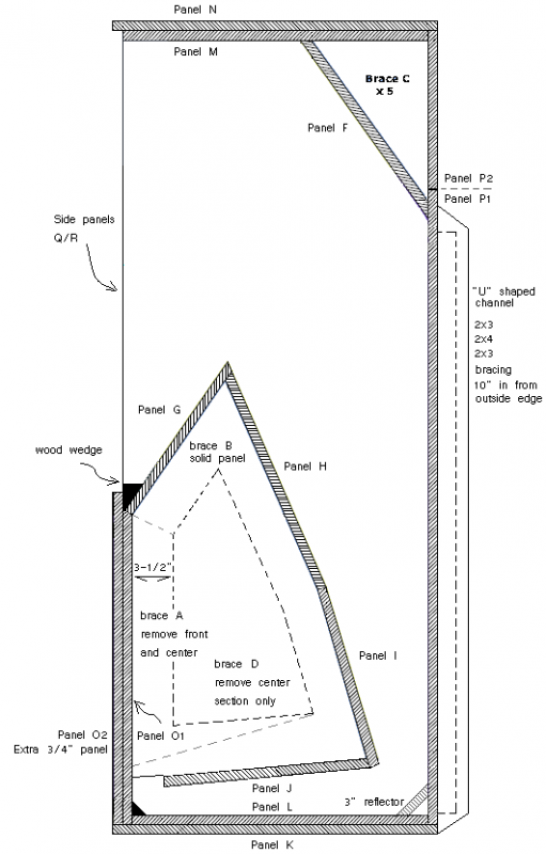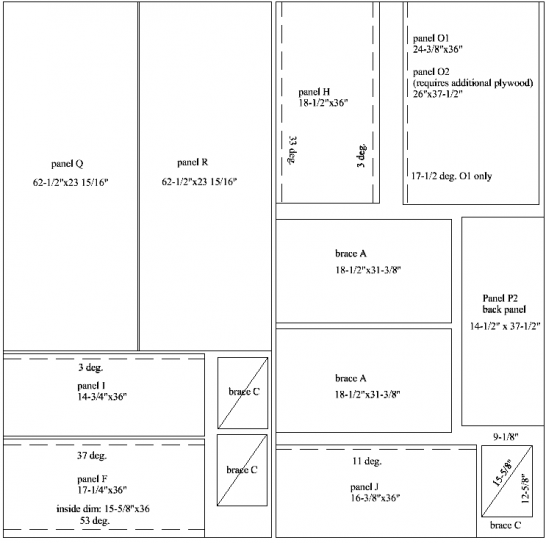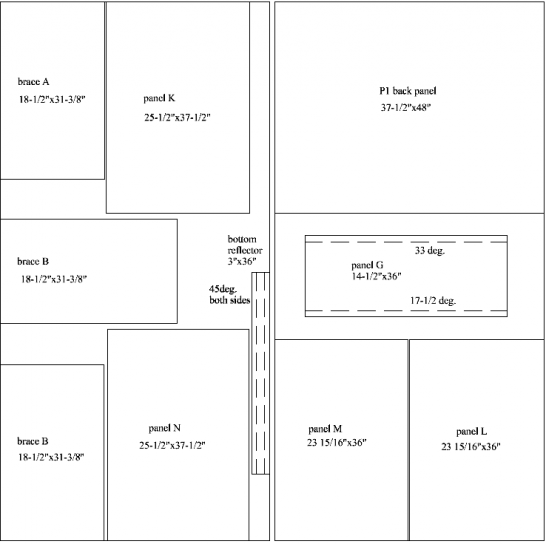Jensen Imperial horn:
Hi everyone.
I recently fabricated a pair of classic, Jensen Imperial, rear loaded horns for a customer. I purchased $10.00 prints from www.decware.com/imperial.htm and made some simple modifications to the drawings. The primary change is the utilization of a single 21 inch driver (Steve uses two 15 inch drivers). I'm sharing my mods and cutting list with you free of charge, but suggest that you purchase the actual prints from decware. I'm not going to give the dimensions to this project as I wish to avoid infringing on Steve's intellectual property. I do, however, offer cutout drawings for the various pieces. You will be hard pressed to arrange them in the proper dimension without Steve's drawings, so save yourself a headache and go get those drawings. They're affordable, and it's a very simple process to locate them in either Decware's Master Catalog, or on the hyper-link page listed at the beginning of this paragraph.
You'll need 9 sheets of high quality 4'x8' plywood to construct two horns. I show 4 sheets of cutouts, but if you look closely, you see that an extra piece of plywood is required if you wish to double the thickness of the speaker baffle. The B&C is so powerful, that I urge you to double up on the plywood. Use a paintbrush, or paint-roller to spread glue between plywood layers. Simply wiggling a glue bottle over the joint in question isn't going to be strong enough. Purchase a gallon of Tight-Bond glue and be generous--go heavy on the screws too. I use two inch grabber style screws in large quantities. You'll notice that I modified the rear braces: I'm using two wooden "U" shaped channels created by joining a 2x3 on edge to a 2x4 laying flat to another 2x3 on edge. I fasten (with plenty of screws and glue!) these braces to the back of the horn ten inches in from both outside edges. This really stiffens the rear panel and tunes the enclosure to offer tight, smooth bass. Steve uses a little less bracing and has a little bit different sounding bass as a result. I would recommend you experiment with the quantity of bracing and decide what sonic signature you prefer--loose, or tight, these are very impressive sounding horns.
The horns I fabricated employed two B&C 21" subwoofers (one per horn). These drivers aren't really ultra deep sub-woofers in my mind, but make incredible sounding bass from 30hz to 120hz in this particular enclosure. The sound is smooth, tight, and they generate so much acustic power that the hair on my arms flutters at high volume 15 feet away. Another bonus: this driver can handle 2000 watts RMS. Unbelievable! It takes several weeks of hard use to loosen these driver up. My god they're stiff.
Besides having the ability to handle impressive wattage, B&C's 21SW152 does a fantastic job of controlling harmonic distortion which shows up in the sweet sonic signature this combination produces. What a great rig.
Power is supplied in the form of two QSC-RMX-2450 amplifiers running in mono-bridge mode with no internal filtering--that's 2400 watts per horn. I'm using a Behringer Ultra Curve to adjust the parametric EQ which is set up to add +10db at 20hz, then slowly fall to 0db at 100hz, after which it continues to slope down and gradually remove -5db. This insures that the mid range is free of bass artifacts.
I recently fabricated a pair of classic, Jensen Imperial, rear loaded horns for a customer. I purchased $10.00 prints from www.decware.com/imperial.htm and made some simple modifications to the drawings. The primary change is the utilization of a single 21 inch driver (Steve uses two 15 inch drivers). I'm sharing my mods and cutting list with you free of charge, but suggest that you purchase the actual prints from decware. I'm not going to give the dimensions to this project as I wish to avoid infringing on Steve's intellectual property. I do, however, offer cutout drawings for the various pieces. You will be hard pressed to arrange them in the proper dimension without Steve's drawings, so save yourself a headache and go get those drawings. They're affordable, and it's a very simple process to locate them in either Decware's Master Catalog, or on the hyper-link page listed at the beginning of this paragraph.
You'll need 9 sheets of high quality 4'x8' plywood to construct two horns. I show 4 sheets of cutouts, but if you look closely, you see that an extra piece of plywood is required if you wish to double the thickness of the speaker baffle. The B&C is so powerful, that I urge you to double up on the plywood. Use a paintbrush, or paint-roller to spread glue between plywood layers. Simply wiggling a glue bottle over the joint in question isn't going to be strong enough. Purchase a gallon of Tight-Bond glue and be generous--go heavy on the screws too. I use two inch grabber style screws in large quantities. You'll notice that I modified the rear braces: I'm using two wooden "U" shaped channels created by joining a 2x3 on edge to a 2x4 laying flat to another 2x3 on edge. I fasten (with plenty of screws and glue!) these braces to the back of the horn ten inches in from both outside edges. This really stiffens the rear panel and tunes the enclosure to offer tight, smooth bass. Steve uses a little less bracing and has a little bit different sounding bass as a result. I would recommend you experiment with the quantity of bracing and decide what sonic signature you prefer--loose, or tight, these are very impressive sounding horns.
The horns I fabricated employed two B&C 21" subwoofers (one per horn). These drivers aren't really ultra deep sub-woofers in my mind, but make incredible sounding bass from 30hz to 120hz in this particular enclosure. The sound is smooth, tight, and they generate so much acustic power that the hair on my arms flutters at high volume 15 feet away. Another bonus: this driver can handle 2000 watts RMS. Unbelievable! It takes several weeks of hard use to loosen these driver up. My god they're stiff.
Besides having the ability to handle impressive wattage, B&C's 21SW152 does a fantastic job of controlling harmonic distortion which shows up in the sweet sonic signature this combination produces. What a great rig.
Power is supplied in the form of two QSC-RMX-2450 amplifiers running in mono-bridge mode with no internal filtering--that's 2400 watts per horn. I'm using a Behringer Ultra Curve to adjust the parametric EQ which is set up to add +10db at 20hz, then slowly fall to 0db at 100hz, after which it continues to slope down and gradually remove -5db. This insures that the mid range is free of bass artifacts.



